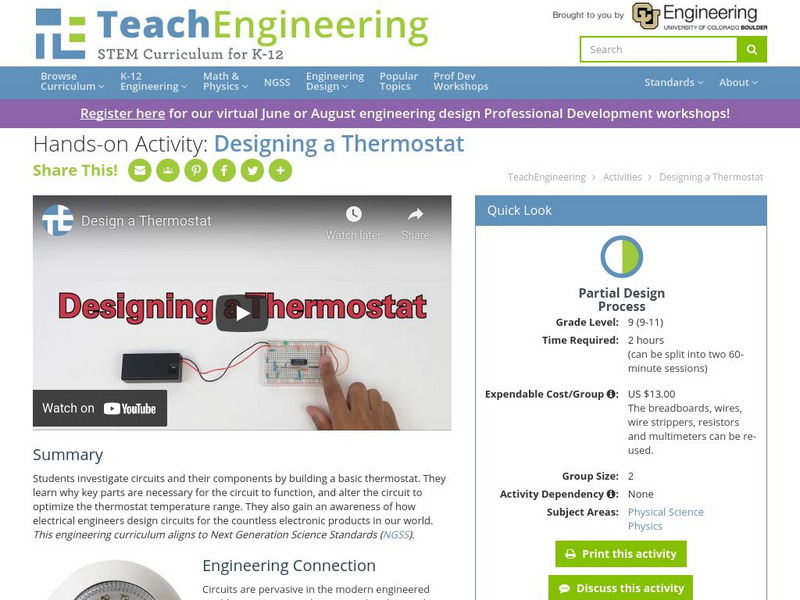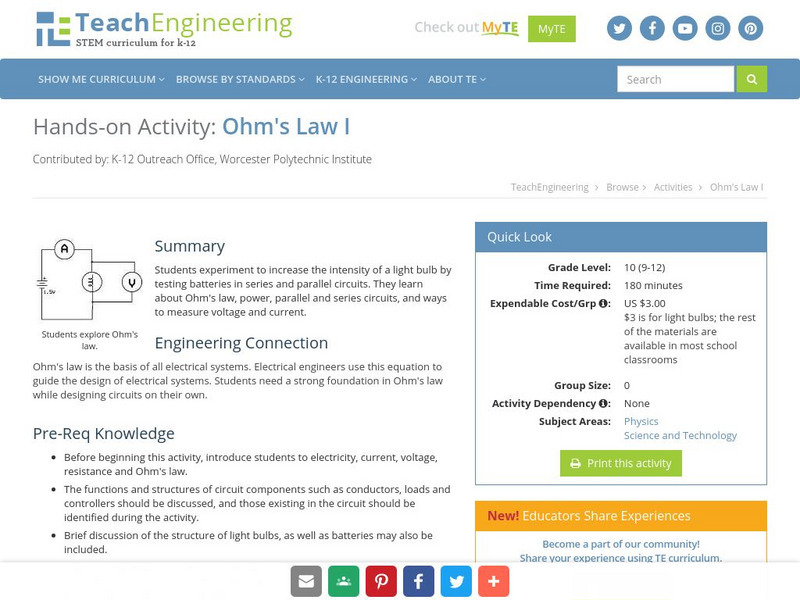TeachEngineering
Teach Engineering: Electrifying the World
This lesson introduces students to the fundamental concepts of electricity. This is accomplished by addressing questions such as "How is electricity generated," and "How is it used in every-day life?" The lesson also includes...
TeachEngineering
Teach Engineering: Introduction to Circuits and Ohm's Law
Students will explore the basics of dc circuits analyzing the light from light bulbs when connected in series and parallel circuits. Ohm's Law and the equation for power dissipated by a circuit will be the primary equations used. Using...
TeachEngineering
Teach Engineering: Designing a Thermostat
Students investigate circuits and their components by building a basic thermostat. They learn why key parts are necessary for the circuit to function, and alter the circuit to optimize the thermostat temperature range. They also gain an...
TeachEngineering
Teach Engineering: What Is Bluetooth?
Students learn about electrical connections, how they work, and their pervasiveness in our world. Two specific skills explored are Morse code and the function of Bluetooth. Using bluetooth, they control LEGO robots remotely from Android...
TeachEngineering
Teach Engineering: A New Angle on Pv Efficiency
Students examine how the orientation of a photovoltaic (PV) panel relative to the sun affects the efficiency of the panel. Using sunshine (or a lamp) and a small PV panel connected to a digital multimeter, students vary the angle of the...
TeachEngineering
Teach Engineering: Mri Safety Grand Challenge
This module was written for a first year accelerated or AP physics class. It is intended to provide hands on activities to teach end of the year electricity and magnetism topics including the magnetic force, magnetic moments and torque,...
TeachEngineering
Teach Engineering: Sensing Air Pollution
Students learn about electricity and air pollution while building devices to measure volatile organic compounds (VOC) by attaching VOC sensors to prototyping boards. In the second part of the activity, students evaluate the impact of...
TeachEngineering
Teach Engineering: Ohm's Law I
Students will work to increase the intensity of a light bulb by testing batteries in series and parallel circuits. It analyzes Ohm's Law, power, parallel and series circuits, and ways to measure voltage and current.
Other
Westinghouse Electric Co.: George Westinghouse
A brief biography from the company that bears his name. George Westinghouse was a prolific inventor, and this biography recounts his many inventions, beginning with the air brake which greatly increased safety on the railroads.
Sophia Learning
Sophia: Mechanical Energy: Lesson 3
This lesson will explain how an electric current produces an electric force, which can be used to create mechanical energy. It is 3 of 4 in the series titled "Mechanical Energy."
Sophia Learning
Sophia: Mechanical Energy: Lesson 4
This lesson will explain how an electric current produces an electric force, which can be used to create mechanical energy. It is 4 of 4 in the series titled "Mechanical Energy."
The Franklin Institute
Franklin Institute Online: Electrified Ben
This site from the Franklin Institute Online provides a somewhat simplistic but interesting tale of Ben's electrical activities. Fine link to "electricity bells", in Franklin's own words. Some other links to projects, maybe not so...
Mocomi & Anibrain Digital Technologies
Mocomi: What Is Ohm's Law?
Explains Ohm's Law which is the mathematical relationship between electric current, resistance, and voltage.
Smithsonian Institution
Lemelson Center: Spark!lab: Make a Light Bulb
This lab shows students how to make a light bulb using 6V battery, wire, cork, and a nail. Print a form where you can record your results.
TeachEngineering
Teach Engineering: The Power of Food
Students imagine they are stranded on an island and must create the brightest light possible with the meager supplies they have on hand in order to gain the attention of a rescue airplane.
University of Colorado
University of Colorado: Ph Et Interactive Simulations: Circuit Construction Kit
Build circuits with resistors, light bulbs, batteries, and switches. Take measurements with the realistic ammeter and voltmeter. View the circuit as a schematic diagram, or switch to a life-like view.
Other popular searches
- Bill Nye Electrical Current
- Electrical Currents Science
- Electrical Current Problems
- Electrical Current and Salt
- Ac/dc Electrical Current
- Physics Electrical Current
- Bill Nye: Electrical Current












